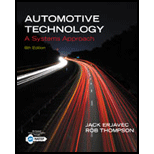
Automotive Technology: A Systems Approach (MindTap Course List)
6th Edition
ISBN: 9781133612315
Author: Jack Erjavec, Rob Thompson
Publisher: Cengage Learning
expand_more
expand_more
format_list_bulleted
Concept explainers
Textbook Question
Chapter 50, Problem 2ASRQ
While discussing what affects the amount of pressure exerted by the brakes: Technician A says that the shorter the line, the more pressure there will be. Technician B says that braking force will increase if the size of the pistons in a master cylinder are increased. Who is correct?
- Technician A only
Expert Solution & Answer
Trending nowThis is a popular solution!

Students have asked these similar questions
How does cushioning affect the speed of the piston when the cylinder is cushioned at end of the stroke? which one correct ?
1-cushioning increases the speed of piston at the beginning of the stroke
2- cushioning increases the speed of piston near the end of the stroke
3-cushioning decreases the speed of piston at the beginning of the stroke
4-cushioning decreases the speed of piston near the end of the stroke
When performing the air brake system leakage test, the Certified Inspector must reject the vehicle if the system does not maintain 100 P.S.I. (Perform this test for 1 minute with the brakes fully applied & the engine running on single and/ or combination vehicles). True or False?
The purpose of the master cylinder is to ______.
a. generate the hydraulic pressure needed to apply the brake mechanisms b. automatically pump the brakes during panic stops c. supply mechanical force to the brake mechanisms d. All the answers are correct.
The purpose of a pressure differential valve is being discussed. Technician A says it alerts the driver if pressure is lost in either portion of a dual braking system. Technician B says it provides the needed pressure balance between the front and rear brakes. Who is correct?
a. A only b. B only c. both A and B d. neither A nor B
In a diagonal split brake system, how would the vehicle brake in the event of a failure?
a. One front wheel and its rear wheel will brake. b. One front wheel and the opposite rear wheel will brake. c. Only the front wheels will brake. d. All four wheels will have half the total braking force.
Chapter 50 Solutions
Automotive Technology: A Systems Approach (MindTap Course List)
Ch. 50 - Explain why bleeding air out of a hydraulic system...Ch. 50 - Explain why modern hydraulic braking systems are...Ch. 50 - Describe the functions of the hydraulic system...Ch. 50 - When the brakes are applied on a moving car, the...Ch. 50 - What is the purpose of the master cylinder vent...Ch. 50 - What is the purpose of the master cylinder...Ch. 50 - Explain why a height-sensing proportioning valve...Ch. 50 - A three-function combination valve has a brake...Ch. 50 - Explain how vacuum is used to provide a power...Ch. 50 - The purpose of the master cylinder is to. generate...
Ch. 50 - Which of the following can lead to brake hose...Ch. 50 - True or False? Metering and proportioning valves...Ch. 50 - Which type of brake requires greater application...Ch. 50 - Which of the following is not a factor in...Ch. 50 - Which of the following could cause an extremely...Ch. 50 - A vehicles power brakes are grabbing: Technician A...Ch. 50 - While discussing what affects the amount of...Ch. 50 - The metering valve portion of a combination valve...Ch. 50 - While discussing quick take-up master cylinders:...Ch. 50 - While bleeding a brake system: Technician A...Ch. 50 - The basic frictional parts of a brake system are...Ch. 50 - Vehicle dynamics during braking are being...Ch. 50 - Pressure bleeding is being discussed: Technician A...Ch. 50 - Technician A says that the master cylinder should...Ch. 50 - The hydraulic system of the hydro-boost and...
Knowledge Booster
Learn more about
Need a deep-dive on the concept behind this application? Look no further. Learn more about this topic, mechanical-engineering and related others by exploring similar questions and additional content below.Similar questions
- True or False? Both the clutch and the brake system may share the same master cylinder.arrow_forwardWhile discussing quick take-up master cylinders: Technician A says that this design allows for increased braking power. Technician B says that this design is only used on drum brake systems. Who is correct? Technician A only Technician B only Both A and B Neither A nor Barrow_forwardTrue or False? Disc brakes are not as likely to fade during heavy braking as are drum brakes.arrow_forward
- While diagnosing the cause for an engine having good results from a compression test and cylinder leakage test but poor results from a cylinder power balance test: Technician A says that incorrect valve timing is the most likely cause. Technician B says that a severely worn cam lobe is a likely cause. Who is correct? Technician A Technician B Both A and B Neither A nor Barrow_forwardA brake pad is found to be wearing more on one side than the other. Technician A says this is common in real world situations. Technician B says this is always a clear sign that there’s a problem. Who is correct? Technician A Technician B Both Technician A and B Neither Technician A or Barrow_forwardThe basic frictional parts of a brake system are being discussed: Technician A says that the harder the frictional parts are pushed together, the higher the friction. Technician B says that the harder the frictional parts are pushed together, the more heat is developed. Who is correct? Technician A only Technician B only Both A and B Neither A nor Barrow_forward
- When replacing brake pads on a vehicle: Technician A works on one wheel before beginning work on an-other. Technician B uses a minimum of 52 psi of air pressure to force the piston from the caliper housing. Who is correct?arrow_forwardwhy is brake fluid removed from the master cylinder prior to working on disc brakesarrow_forwardWhile discussing how to remove the piston from a brake caliper: Technician A says that the dust boot should be removed, then a large dull screwdriver should be inserted into the piston groove to pry the piston out. Technician B says that air pressure should be injected into the bleeder screw’s bore to force the piston out of the caliper. Who is correct?arrow_forward
- While discussing pull during braking: Technician A says that this can be caused by one tire being underinflated. Technician B says that a frozen wheel cylinder on one side of the car can cause this. Who is correct? Technician A only Technician B only Both A and B Neither A nor Barrow_forwardTechnician A says that a cylinder wall with too smooth a surface will prevent the piston rings from seating properly. Technician B says that a cylinder wall should have a crosshatch honing pattern. Who is correct? Technician A Technician B Both A and B Neither A nor Barrow_forwardWhat is the function of the folowing system. What is the benefit of vacuum booster. Why is there a spring between primary and secondary pistons. What is the sort of fluids used in vacuum booster and master cylender, and why. Master Cylinder Vacuum Booster Vacuum Hose Diaphragm Secondary Reservoir Secondary Piston WAT LEAVI Spring's Brake Lines Primary Reservoir Primary Piston Vacuum on both sides of Diaphragm ©2000 How Stuff Works to Pedalarrow_forward
arrow_back_ios
SEE MORE QUESTIONS
arrow_forward_ios
Recommended textbooks for you
 Automotive Technology: A Systems Approach (MindTa...Mechanical EngineeringISBN:9781133612315Author:Jack Erjavec, Rob ThompsonPublisher:Cengage Learning
Automotive Technology: A Systems Approach (MindTa...Mechanical EngineeringISBN:9781133612315Author:Jack Erjavec, Rob ThompsonPublisher:Cengage Learning Automotive TechnologyMechanical EngineeringISBN:9781337794213Author:ERJAVEC, Jack.Publisher:Cengage,
Automotive TechnologyMechanical EngineeringISBN:9781337794213Author:ERJAVEC, Jack.Publisher:Cengage,

Automotive Technology: A Systems Approach (MindTa...
Mechanical Engineering
ISBN:9781133612315
Author:Jack Erjavec, Rob Thompson
Publisher:Cengage Learning

Automotive Technology
Mechanical Engineering
ISBN:9781337794213
Author:ERJAVEC, Jack.
Publisher:Cengage,
Mechanical Design (Machine Design) Clutches, Brakes and Flywheels Intro (S20 ME470 Class 15); Author: Professor Ted Diehl;https://www.youtube.com/watch?v=eMvbePrsT34;License: Standard Youtube License